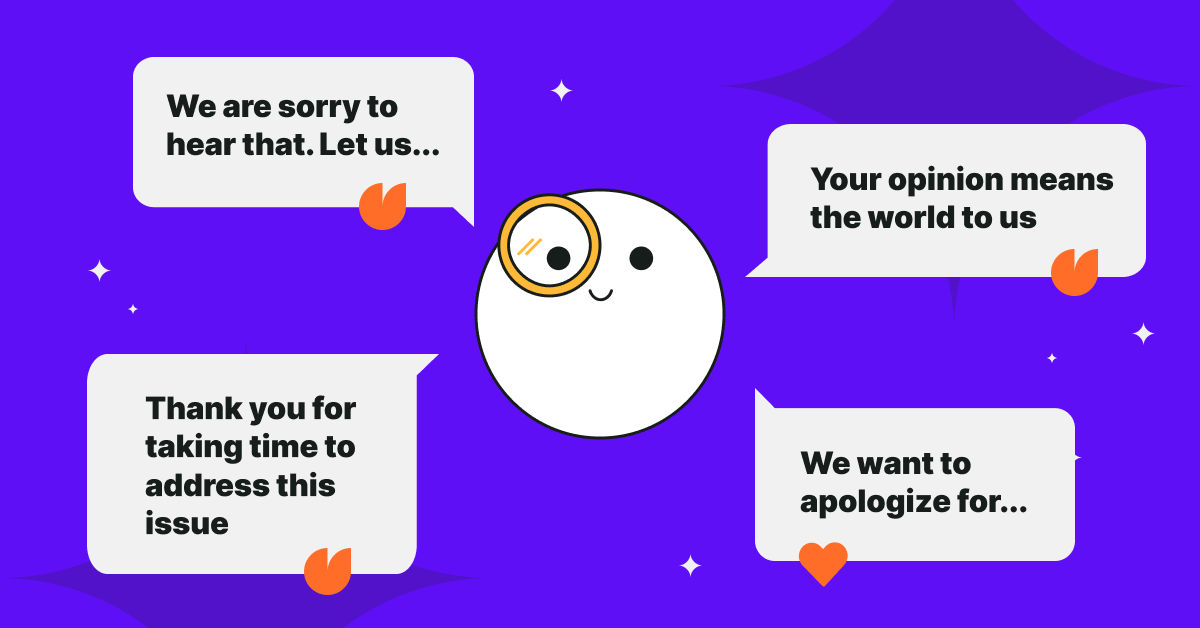Have you ever experienced a customer complaint? If you haven’t, consider yourself lucky: even the biggest fish in the pond got a fair share of them.
Complaints can be stressful and difficult to manage, but they are also a tremendous opportunity for businesses to learn, grow and build better relationships with their customers.
In this post, we will explore the benefits of addressing customer complaints and discuss best practices on how to handle them effectively and efficiently.
Read on to learn more about why it pays to pay attention when a customer raises a concern.
 (1).webp)
What are customer complaints?
Customer complaints are pieces of feedback that let you know where customers experience problems with your product or service. They are opportunities for your business to improve your offering and create a better experience for your users.
Why collecting customer feedback is important
It is no longer a secret that online customer reviews and a great online reputation are essential for your marketing success. It has become a common practice for people to check online reviews before buying a certain service or product.
According to a report by PowerReviews, 99.9% of online shoppers read reviews before making a purchase. And, even more interestingly, a whopping 96% of customers pay particular attention to negative reviews.
In 2023 (and beyond), you simply cannot underestimate the power that even a single review can have.
Besides giving you insights and bringing new clients, gathering customer feedback has many additional benefits and can open a lot of new possibilities for your company.
The best thing is that gathering feedback can be as simple as creating a survey and sending it out. You can, for example, create a survey and embed it on your website to discover your customers' purchasing criteria.
The importance and benefits of customer complaints
Not all feedback is positive, after all. And that’s ok!
Across all industries and product categories, 12.8% of American customers complained to businesses about something in the last decade, according to the American Customer Satisfaction Index. It is not uncommon even for well-established companies to receive complaints on a daily basis.
As an entrepreneur, it may be frustrating to receive criticism and unfavorable comments about a product you have put your heart and soul into. But you should not take it personally.
From a different perspective, customer complaints can prove valuable to your business, resulting in rapid change.
Here's how you can turn customer complaints into a flywheel for your brand.
1. Customer satisfaction enhancement
Many people, when unsatisfied with a product, will keep it to themselves and simply stop using your services.
However, those who do share their reviews, usually express not only their own feelings but those of other customers too. Have you ever seen the reviews starting from “I’m sure I’m not the only person to feel this way…”?
So when you address their feedback and provide a quick resolution, you are likely to make more than one customer happy. As a result, you can entice more customers to stick around.
According to ACSI, customer loyalty is stronger among those who experienced a problem and complained but received successful complaint management.
2. Product or service upgrade
When clients report encountering some problems with your product or service, or simply features or aspects they do not like, it provides a perfect opportunity to improve your offer. You no longer need to look for ways to make your service more appealing to customers to ensure that they keep choosing you over your competitors.
You don’t need to create bug bounty programs or check logs, either: everything is at your fingertips.
Customer complaints serve as a source of insights into the areas you should work on and upgrade. By studying bad reviews you can find new ideas for improving your product that you haven’t thought of before.
For that, you don’t even need to wait for feedback to pour in itself: you can be proactive and ask for it using surveys.
Use a Beta Feature survey template to collect feedback on a feature you've just implemented:
If the user answers negatively, the survey will redirect them to the following question: “What is the reason you haven't tried it yet?”
3. Improvement of policies and procedures
Most companies have a number of policies and procedures designed to make the business run more smoothly.
However, you don’t always know if they are working as intended and suit your company's needs best. Luckily, negative feedback often highlights flaws in your internal processes and contains hints about what is not working or is unclear to customers.
By analyzing this information, you will be able to judge which procedures need improving and which you should simply give up as they are inconvenient or unnecessary.
At the same time, you might also receive feedback about your staff and how well they manage their responsibilities.
4. Boost in customer communication
Customer feedback also serves as a channel of communication between your company and your clients. Statistics show that the customers are likely to switch to a competitor if they feel they're not listened to.
In the 2020 Achieving Customer Amazement Study, 27.9% of respondents claimed that they would be extremely willing to switch for better customer experience, and 35.5% would be somewhat willing to do so.
For many of them, it is important to know that their opinions are taken into account. Furthermore, when clients know that there is an open line of communication and their input matters, they are more likely to stay loyal to your company and spread the good word.
.webp)
5. Positive impact on brand image
Having an open channel of communication where customers can report problems with your service or bad experiences also positively affects your brand image. It improves your reputation and makes your company look trustworthy and caring.
The more you tend to go the extra mile to address the reported issues, the more satisfied your clients will be. And happy customers are more likely to share their good experiences with their colleagues, friends, and family, which only helps to spread the word and build your reputation.
You can run a quick brand equity survey to determine if your complaint management efforts are effective. With this type of survey, you can measure how your brand compares to your competitors:
How to Handle Customer Complaints
We have already established that complaints are essential for your product growth, but the way you deal with them is crucial.
For example, arguing back is one of the worst ways of dealing with bad reviews. Even if you are not at fault, getting on the defensive will only make you look weak.
In addition, it can be seen as a red rag by your customers, leading them down a rabbit hole.
That is why you should always keep your cool and stay polite.
To calm and reassure your customer, it is always a good idea to apologize right away.
Like it or not, customers complain when their expectations have not been met. Often, they just want to be heard, so let them know that what they’ve got to say matters to you.
Try these 7 proven steps to respond to customer complaints and turn an uncomfortable situation into something constructive for your customers and your business.
- Address your customer by name
- Apologize to the customer
- Sympathize with the customer’s problem
- State you’re solving the problem
- Offer some compensation if applicable
- Ask the customer to change the review
- Accept negative reviews
For more advanced tips and real case examples, check out our in-depth blog post about responding to negative feedback.
How to collect customer feedback
There are quite a few ways to collect customer feedback. If you want to increase volume and get the best results, you can combine them.
#1 Surveys
One of the most common and effective uses is surveys. Similar to feedback forms sent to your clients via email, this method allows you to decide what questions to ask your customers based on your goals.
Survicate allows you to create a multitude of surveys to gather feedback from your customers.
If you would like a quick snapshot of what your customers think of your brand, you can create an NPS survey. Getting low scores should make you reevaluate your customer experience:
More templates are available, both for very quick evaluations and comprehensive feedback. Below is a special template for a "What stops you from signing up" survey. By using it, you will be able to discover what else needs to be changed, improved, or removed in your product or on a sign-up page.
#2 Social media
Using social media for gathering feedback is another popular approach. According to Forbes, social media can be a great place for advertising and selling your product as well as measuring metrics and understanding customer needs. Customers are more likely to leave candid reviews on social network platforms where they have an audience.
#3 Website analytics
You can also learn a lot by checking your website analytics. The following are examples of metrics you can check:
- the most visited pages
- where users spend more time
- details about failed searches
- bounce rate
- which parts of your website are barely viewed
The data can also be expanded with embedded surveys, session recordings, and heat maps, just to name a few examples. You can never have too much data.
Leverage customer complaints today
Customer complaints offer a unique chance for businesses to better understand their clients and enhance the customer service experience. They can actually be a blessing in disguise if you approach them the right way.
Surveys allow you to quickly and effectively gather both negative and positive feedback, which you can use to improve your products and services. In a blink of an eye, you can create, embed, or send surveys with Survicate. There are hundreds of different templates waiting for you—sign up today!

.webp)






.svg)
.svg)
.svg)

.svg)


.svg)







.svg)




.svg)

















.svg)






























.svg)

.svg)
.svg)

.svg)



.svg)






.jpg)
.svg)

.svg)







